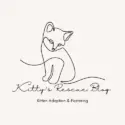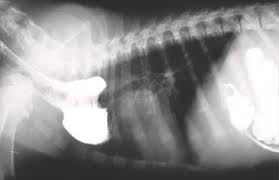Understanding Vascular Ring Anomaly in Kittens
Vascular ring anomaly in kittens is a congenital condition, meaning it’s present from birth, where abnormal development of the major blood vessels around the heart and trachea (windpipe) and esophagus (food pipe) creates a constricting “ring.” This ring can squeeze these vital structures, leading to a variety of health problems, primarily difficulty swallowing solid food. While relatively rare, understanding this condition is crucial for early diagnosis and intervention, offering affected kittens a chance at a healthier life.
What Causes Vascular Ring Anomaly?
During fetal development, a series of aortic arches form and then typically regress, leaving behind the normal adult configuration of major blood vessels. Vascular ring anomalies occur when some of these arches fail to regress as they should, or when they regress abnormally. This results in one or more blood vessels encircling the trachea and esophagus.
Several types of vascular ring anomalies exist, with the most common being a persistent right aortic arch. In this scenario, the aorta, the main artery carrying blood from the heart, develops on the right side of the body instead of the left. A ligament called the ligamentum arteriosum, which connects the aorta to the pulmonary artery, then completes the ring, trapping the trachea and esophagus. Other, less frequent, variations involve double aortic arches, aberrant subclavian arteries, or other abnormal vessel formations.
While the exact cause of these developmental errors remains unknown, a genetic predisposition is suspected in some cases. However, more research is needed to pinpoint specific genes involved.
Symptoms and Diagnosis
The most prominent symptom of vascular ring anomaly in kittens is regurgitation, especially when transitioning to solid food. Unlike vomiting, which involves forceful expulsion of stomach contents, regurgitation is a passive process where undigested food is brought back up shortly after eating. Kittens with this condition may also exhibit:
- Difficulty swallowing: They may struggle to get food down, cough, or gag during mealtimes.
- Poor growth and weight gain: The constriction limits the amount of food they can successfully ingest and digest.
- Pneumonia: Aspiration pneumonia can occur if food is accidentally inhaled into the lungs during regurgitation.
- Respiratory distress: In severe cases, the trachea can be significantly compressed, leading to breathing difficulties.
Diagnosing a vascular ring anomaly requires a thorough veterinary examination and diagnostic imaging. Initially, a veterinarian will assess the kitten’s history, perform a physical examination, and may order blood tests to rule out other potential causes of the symptoms.
The following imaging techniques are commonly used to confirm the diagnosis:
- Radiography (X-rays): Chest X-rays can sometimes reveal an enlarged esophagus or signs of aspiration pneumonia.
- Fluoroscopy: This real-time X-ray allows the veterinarian to observe the passage of a contrast agent (barium) through the esophagus, highlighting any constrictions or abnormalities.
- Esophagoscopy: A small camera is inserted into the esophagus to directly visualize the area and identify any narrowing or inflammation.
- Angiography or CT angiography: These advanced imaging techniques use contrast dye to visualize the blood vessels and identify the specific type of vascular ring anomaly present.
Treatment Options for Vascular Ring Anomaly
The primary treatment for vascular ring anomaly is surgical correction. The goal of surgery is to divide the constricting vessel or ligament, relieving the pressure on the trachea and esophagus. The specific surgical approach depends on the type of anomaly present. In the case of a persistent right aortic arch, the ligamentum arteriosum is typically divided.
The surgery is ideally performed by a board-certified veterinary surgeon with experience in cardiovascular procedures. Post-operative care is crucial for a successful outcome. This may include:
- Pain management: Medications are administered to keep the kitten comfortable.
- Nutritional support: A feeding tube may be necessary initially to ensure adequate nutrition while the esophagus heals.
- Antibiotics: To prevent or treat any post-operative infections.
- Monitoring for complications: The kitten will be closely monitored for signs of aspiration pneumonia, esophageal stricture (narrowing), or other complications.
Long-Term Outlook and Management
The prognosis for kittens with vascular ring anomaly following surgical correction is generally good, especially if the surgery is performed early in life. Many kittens experience significant improvement in their ability to eat and gain weight after the procedure.
However, some kittens may continue to experience mild regurgitation or esophageal dilation even after surgery. In these cases, management strategies may include:
- Feeding small, frequent meals: This can help reduce the amount of food in the esophagus at any given time.
- Elevated feeding: Raising the food bowl can aid gravity in moving food down the esophagus.
- Soft or liquid diet: These diets are easier to swallow and less likely to cause regurgitation.
- Medications: In some cases, medications may be prescribed to help reduce esophageal inflammation or improve esophageal motility.
Conclusion
Vascular ring anomaly is a serious but treatable condition in kittens. Early diagnosis and surgical intervention are essential for improving the kitten’s quality of life and preventing long-term complications. By understanding the causes, symptoms, and treatment options for this condition, breeders, owners, and veterinarians can work together to ensure that affected kittens receive the care they need to thrive. While ongoing management may be necessary in some cases, many kittens with vascular ring anomalies can live happy and healthy lives after successful surgical correction.

